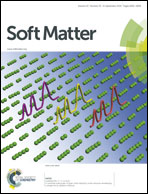Noncovalent fabrication and tunable fusion of block copolymer–giant polyoxometalate hybrid micelles†
Abstract
The block copolymers (BCs), as structure-directing agents, co-assembling with nanoscale inorganic additives is an important route to fabricate nanostructured hybrid materials. In this work, we present a facile approach to fabricate hybrid micelles composed of BCs and polyoxometalates (POMs), in which the POM clusters are premodified with the groups that can specifically interact with a certain BC block. A representative POM (NH4)42[Mo132O372(CH3COO)30(H2O)72] (Mo132) is chosen as the example and encapsulated with cationic molecules containing carboxyphenyl groups through electrostatic interactions, and then the resulting hybrid complex can further co-assemble with poly(styrene-block-4-vinylpyridine) (PS-b-P4VP) through hydrogen bonding with the pyridine groups, which leads to the formation of hybrid micelles and the localization of Mo132 in the micelle cores. The micelles exhibit a high stability despite time and dilution. Furthermore, the fusion of the micelles can be readily adjusted by varying the length of PS blocks, which is promising to be used in constructing polymer–POM hybrid materials with discrete or continuous hybrid domains. This work is based on the electrostatic premodification of POMs and thus its concept is generally suitable for the whole anionic POM system, which may create a large class of BC–POM nanocomposites with tunable structures.


 Please wait while we load your content...
Please wait while we load your content...